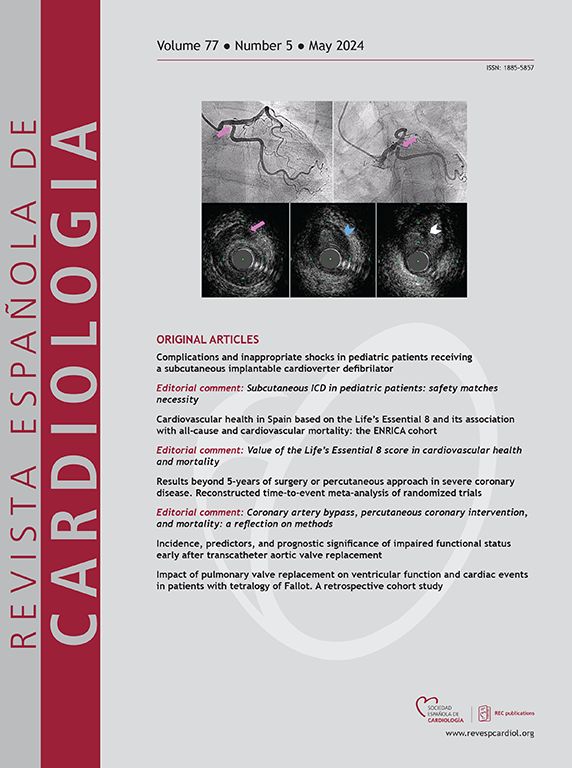Superioridad de la planimetría 3D sobre el tiempo de hemipresión para evaluar el área valvular mitral tras la reparación mitral percutánea de borde a borde
IF 5.9
2区 医学
Q2 Medicine
引用次数: 0
Abstract
Introduction and objectives
There is limited evidence to identify the most accurate method for measuring the mitral valve area (MVA) after percutaneous edge-to-edge mitral repair. Our objective was to evaluate the optimal method in this context and its correlation with the mean transmitral gradient.
Methods
A registry of patients undergoing percutaneous mitral repair was conducted, analyzing different methods of measuring MVA and their correlation with the mean gradient.
Results
We analyzed data from 167 patients. The mean age was 76 ± 10.3 years, 54% were men, and 46% were women. Etiology was degenerative in 45%, functional in 39%, and mixed in 16%. Postclip MVA measurements were 1.89 ± 0.60 cm2 using pressure half-time (PHT), 2.87 ± 0.83 cm2 using 3D planimetry, and the mean gradient was 3 ± 1.19 mmHg. MVA using 3D planimetry showed a stronger correlation with the mean gradient (r = 0.46, P < .001) than MVA obtained by PHT (r = 0.19, P = .048). Interobserver agreement was also higher with 3D planimetry than with PHT (intraclass correlation coefficient of 0.90 vs 0.81 and variation coefficient of 9.6 vs 19.7%, respectively).
Conclusions
Our study demonstrates that the PHT method significantly underestimates MVA after clip implantation compared with direct measurement using transesophageal 3D planimetry. The latter method also correlates better with postimplantation gradients and has less interobserver variability. These results suggest that 3D planimetry is a more appropriate method for assessing postclip mitral stenosis.
在评估经皮二尖瓣边缘对边缘修复术后的二尖瓣面积时,三维平面测量法优于半压时间法
引言和目的目前,确定经皮二尖瓣边缘对边缘修复术后测量二尖瓣面积(MVA)最准确方法的证据有限。我们的目的是评估在这种情况下的最佳方法及其与平均二尖瓣传导阶差的相关性。方法对接受经皮二尖瓣修复术的患者进行登记,分析测量二尖瓣瓣口面积的不同方法及其与平均阶差的相关性。平均年龄为 76 ± 10.3 岁,54% 为男性,46% 为女性。病因为退行性病变的占 45%,功能性病变的占 39%,混合性病变的占 16%。使用压力半定时法(PHT)测量的夹板后MVA为(1.89 ± 0.60)平方厘米,使用三维平面测量法测量的MVA为(2.87 ± 0.83)平方厘米,平均梯度为(3 ± 1.19)毫米汞柱。使用三维平面测量法获得的 MVA 与平均阶差的相关性(r = 0.46,P <.001)高于 PHT 获得的 MVA(r = 0.19,P = .048)。结论我们的研究表明,与使用经食道三维平面测量法直接测量相比,PHT 法明显低估了夹片植入后的 MVA。后者与植入后梯度的相关性更好,观察者之间的变异性也更小。这些结果表明,三维平面测量法是评估夹片植入后二尖瓣狭窄的更合适的方法。
本文章由计算机程序翻译,如有差异,请以英文原文为准。
求助全文
约1分钟内获得全文
求助全文
来源期刊

Revista espanola de cardiologia
医学-心血管系统
CiteScore
4.20
自引率
13.60%
发文量
257
审稿时长
28 days
期刊介绍:
Revista Española de Cardiología, Revista bilingüe científica internacional, dedicada a las enfermedades cardiovasculares, es la publicación oficial de la Sociedad Española de Cardiología.
 求助内容:
求助内容: 应助结果提醒方式:
应助结果提醒方式:


